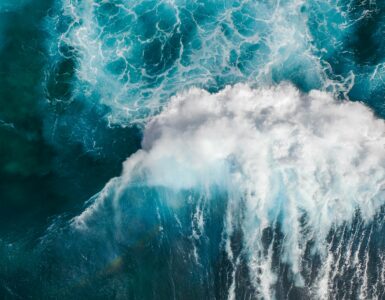In the last few decades, there has been an increase in the number of floods across the In the last few decades, there has been an increase in floods across the globe. This is mainly due to climate change, but many other factors play a part. Many cities around the world continue to face the risks of floods. There are many aspects of this phenomenon that we will be discussing today, but first, let us explain what floods are.
What are floods?
Floods occur when large amounts of water overflow onto usually dry land. When occurring naturally, they can bring benefits. One such example would be flooded rice paddies around Asia, which helps with the irrigation of rice crops. However, this is usually not the case in urban areas such as cities. As the population density of urban areas is high, there is often severe damage caused by floods.
Types of flood
Coastal floods
Coastal floods are floods in regions along the coast. They are often caused by intense storms, such as typhoons and hurricanes. These storms create large waves called storm surges, which cause an increase in water levels. This, in turn, causes coastal floods. As such, coastal land that is low-lying is susceptible to flooding.
Aside from intense storms, they can be caused by tsunamis as well. Tsunamis are giant waves that are created when an earthquake or a volcano eruption occurs under the sea.
Flash floods
Flash floods are often caused by heavy rainfall, and they occur unexpectedly and usually do not last long, and they are categorised by the rapid rise in water levels. While flash floods are often caused by rainfall, they can also be caused by coastal and river floods.
River floods
River floodRiver floods are floods that are caused by river water overflowing the river banks. Like flash floods, they can be caused by heavy rainfall; however, they can also be caused by snowmelt and the failure of dams.
Causes
Now that we have talked a little about the most common types of floods, we will be discussing what they are caused by.
Rainfall
Rainfall is measured by the amount of rain that falls onto the ground, and it can be estimated based on its duration, frequency, and intensity. Despite that, rainfall is usually only measured based on its intensity, and this can be calculated by dividing the total rainwater in mm by its duration in hours. An increase in rainfall intensity can cause a higher risk of floods.
Snowmelt
Snowmelt occurs when, well, snow melts. More specifically, it is the surface runoff when that happens. If you live in an area with a temperate climate, you will know that the ice and snow on the ground will melt when spring comes. The snowmelt will cause a rise in water levels of water bodies. As such, there would be an increase in the probability of flooding. Volcanic eruptions can also cause snowmelt, but this is rarer.
Storm surges
When the sea level suddenly rises, more water is piled up against a coastline’s normal tides. This is called a storm surge, and it occurs during intense storms, such as the earlier mentioned typhoons and hurricanes. The powerful winds created in these storms will blow the water towards the coastline, resulting in huge waves that will result in floods when they crash beyond the coastline.
When manmade structures fail

Dams can be a good thing, but what happens if they fail? When manmade structures such as dams, floodwalls, and levees fail, the areas downstream will be flooded. Just imagine waking up to see giant waves crashing on your entire village, even though you live high up in the mountains. Scary!
Reasons for flood-prone regions
We know that floods can occur anywhere, but certainly, some places are more vulnerable to floods than others. So, why are these places more prone to flooding?
Capacity of channels
To mitigate floods, the government usually builds river channels or canals. This can help to drain water away from urban areas as fast as possible. However, what happens when rainfall exceeds the amount of water that these channels can hold? This is why some cities still face floods, often even with channels. The government would need to work on the capacity of such channels to deal with the high surface runoff faced in that area.
Closeness to water bodies
The closer a city is to significant water bodies, the more likely it is to be flooded. This includes cities such as Manila, which is sandwiched between Manila Bay and Laguna de Bay. Another city would be Tōkyō, which is situated along the Bay of Tōkyō. If you have watched the anime movie “Weathering with You”, you will know what I mean.

Elevation of land
Some places have low land elevation, making them more likely to face floods. One such example is Amsterdam, which has an elevation below sea levels. However, the Dutch came up with many ways to prevent their biggest city from being flooded.
Surface cover permeability
If you have done some gardening before, you would probably have noticed how fast the water seeps into the soil. This is the same in preventing floods. Surfaces that are covered in vegetation are more porous than their concrete counterparts. Since urban areas are often covered in impervious surfaces, they are thus more susceptible to floods.
Impacts
Economic impacts
In a major flood, the first thing that usually occurs is energy disruption. There are many causes to this. Floods can firstly destroy power lines and cause power outages, and this causes industrial operations to come to a halt. Petrol is also not able to be sent to petrol stations since roads are flooded.
The second thing would be the disruption in transportation. As roads and train tracks are damaged, people cannot get around and contribute to economic activities. A large amount of money and time is also needed to repair these transport infrastructures.
Lastly, industries will also face damages to their equipment and machines. This is mainly for electrical equipment and equipment with motors. Businesses would have to fork out money to get new ones, causing them to lose profits.
Social impacts
On top of the enormous bill that needs to be footed, floods also cause the quality of life to decrease. The most apparent social impact will be the loss of lives, which is caused by collapsing buildings or people getting washed away by floods. Even if you are lucky, you are probably going to end up with injuries as well.
Victims often face hypothermia from being in the water for too long. They may also be emotionally unstable, having lost their homes or, worse, their friends and family. Being homeless means that these victims have to reside in emergency shelters. When floods hit cities, the high population density would mean that many residents will become homeless
When floods occur, clean water may not be accessible – flood water may damage water pipes, and sewage pipes may contaminate the water supply. With contaminated drinking water, there would be an increase in the spread of diseases. Mosquitos may also breed with stagnant water, causing mosquito-borne diseases such as dengue fever and malaria.
Conclusion
While floods may sometimes be a good thing, they can often spell disaster if they hit densely populated areas. While you cannot avoid them altogether, understanding how they are caused will help you minimise them.





Add comment